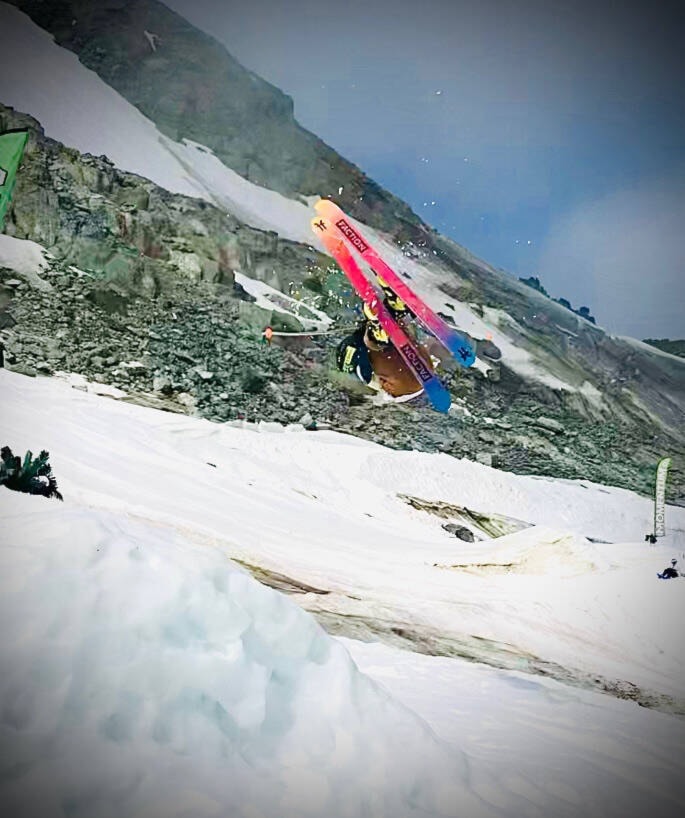Editor’s Note: This is the first of four columns from Yukon freestyle skier Mavik MacKinnon. This week he reflects on training opportunities high in the mountains.
I am passionate about freestyle skiing. It’s an amazing winter sport where I strive to be creative and push the physical limits of what I can do on skis in a terrain park, over rails and jumps. However, much of my training actually occurs in the summer and shoulder seasons. There are many types of summer training for this sport. These include glacier park skiing, water ramp skiing, trampoline training, dry ramp airbag practice and other sports for cross-training. It all plays a big part in the progression of my skills.
This summer, I had the chance to go to Whistler, British Columbia, to train at Momentum, a freestyle terrain park built on a glacier that includes jumps, rails, moguls and airbags. I was super excited because I had heard so much about it. It was a beautiful summer day in July when I loaded the Blackcomb gondola for my first day. After hiking and hopscotching between a series of chairlifts, I got off the Glacier chairlift and saw our destination — a terrain park way up high.
I still had to do a short hike over chunky rocks in my ski boots to arrive at the T-bar that serves the Horstman Glacier, where the Momentum Ski Camp terrain park is. It was a unique experience going from Whistler village, where people were walking around and biking in shorts, to an alpine glacier covered in snow. I was so stoked to be freestyle skiing in the summer. I trained there for five consecutive days with the Whistler Freestyle Club. Luckily for me, I could leave my skis and poles up there each day, so I didn’t have to carry them back and forth.
Training on the glacier was fantastic, and I even learned a few new tricks. However, due to the warm temperatures of mid-July this past year, the skiing area was much smaller than earlier in the season. During our sessions, there were several potentially dangerous rock falls nearby. The experience was still beneficial, though, because I don’t usually get to ski in the summer at all. It was a genuinely great exploit, although I’d recommend going earlier in the summer.
After skiing at Momentum, I turned my attention to the Whistler water ramp training facility at the bottom of Blackcomb Mountain. They have two different-sized (and huge!) water ramps and four trampolines. The ramps are plastic-coated wooden ramps that get sprinkled with water as you ski down, do an inverted trick and then land in a pool.
The water was cold, so I wore a wetsuit, and swimming out of the pool with skis on is awkward and requires a bit of technique. Water is tough on skis, so I used old skis for water ramping. I have a little leash on each ski so that if one of them pops off during the landing, it doesn’t end up at the bottom of the pool. After doing a few hours of water ramping, I was pretty tired. Imagine swimming with your skis on, repeatedly walking up the stairs to the top of the ramp in your wet ski boots and carrying your skis each time.
I did several days of water ramps and trampoline with the Whistler Development Team and had a good time training with my friends. It was also great having SuperTramps (a brand of very bouncy trampolines) beside the ramps so I could practice there before trying bigger tricks into the pool. I learned several new tricks during those sessions and was very happy with them.
The last part of my summer included visiting my grandparents in Quebec before school started. Despite it being August, I took my skis with me. I always take advantage of visiting my family in Quebec to train at Acrobatx, another water ramp facility on the outskirts of Quebec City. I’ve been there several times, and it has incredible national-level coaches. Just like the facility in Whistler, Acrobatx also has super trampolines. The days are longer there, so they break it up a bit. We did a warm-up in the morning, followed by a one-hour trampoline session. After that was an hour-and-a-half of water ramping before lunch. We repeated this in the afternoon.
Even though there is a flow of water bubbles in the pools to break the water surface impact and offer depth perception (just like divers have), after a few days, my body was quite sore due to the physical stress of hitting the water with skis on. Some athletes try to reduce the impact by drilling or cutting holes in their skis. I might try this in the future.
I had a fantastic summer of training in Whistler and Quebec at Acrobatx and was well-prepared for the upcoming winter season of competing and on-snow training. Let’s hope I achieve some of my goals!
I am thankful for the support of local businesses, Winterlong and Yukon Built, for helping me with some of my training and competing expenses, Freestyle Whistler for the affiliation, support and coaching to compete at these great events, and Mount Sima for providing me and the local community with a great terrain park. The Yukon Government and Sport Yukon also have great financial support opportunities for many athletes. Before I conclude, I want to give a special thanks to the Northern Lytes Youth Sport Development Fund for their support this year. Thank you!
